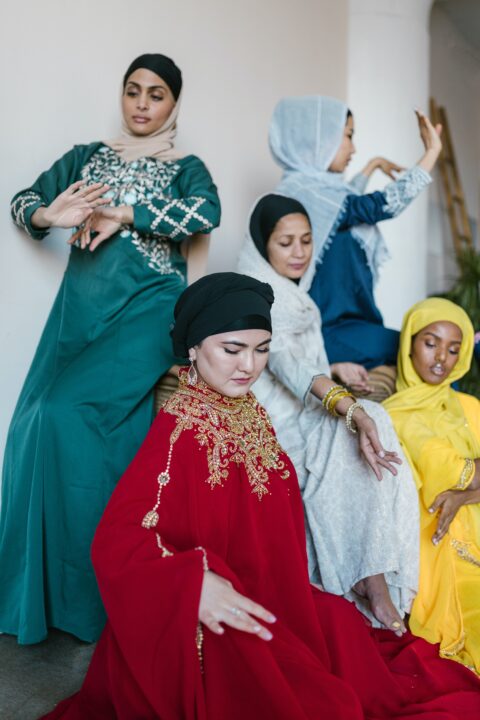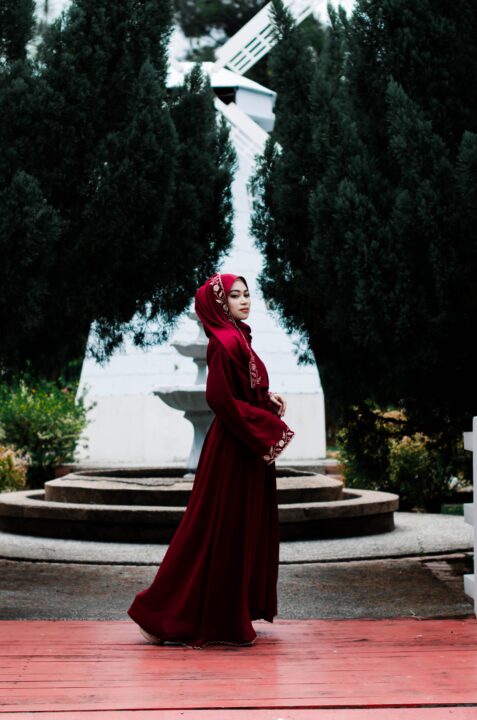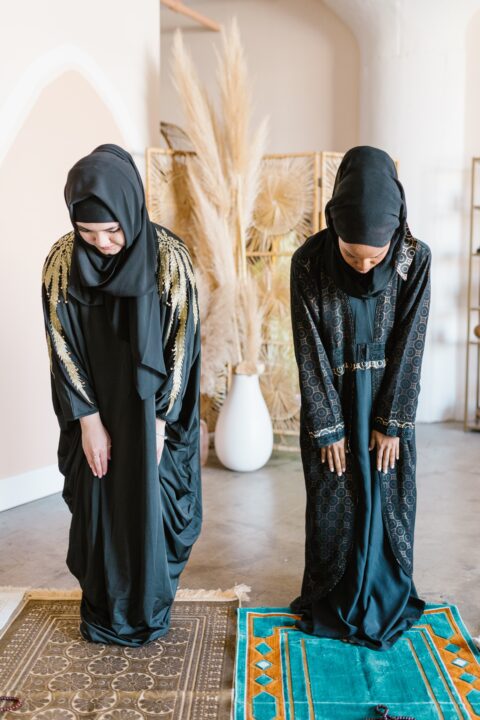Lebanese traditional clothing is a richly woven cloth with an essence that reflects the country’s distinct ancestry. Lebanese diversity in culture contributes to its growth and it is one of the few countries with hundreds of celebrations and festivals all year round. There is also a diversity of clothing between the urban and rural areas commonly seen among the Lebanese women, which is mostly seen in the clothing decoration and rich embroidery.
However, covering the body is a popular clothing style among Lebanese women, irrespective of their status and environment. Also, Lebanese women cover their faces with veils, hair, and legs. Muslim women wear their hijab, while Christian women wear head ties, cloaks, and veils to cover their bodies. Lebanese females don’t take off their headscarves unless there are no men around or passing by, so if a man comes around, they quickly put on their headscarves.
In this article, we’ll focus mainly on Lebanese traditional clothing, discovering not only outstanding fabrics and clothing but also catchy stories and myths that have been passed down through generations. These are some of the popular ethnic clothing worn by Lebanese, which shows their rich cultural origin.
10 Lebanese Traditional Clothing
Lebanese traditional clothing signifies modesty. Their clothing is a long dress with long sleeves and a short silk, satin, or cotton jacket. Tiny embroidery, scarves and sometimes baggy trousers are commonly worn by their women, irrespective of where they came from and their status. However, Lebanese men’s clothing is simple and common both in rural and urban areas, such as the kufta (embroidered vest worn by men), tarboush, shesh, and sherwal.
Let’s proceed by specifying the 10 Lebanese traditional clothing.
1. The Abaya
-

ade rifaie,pexels, 9316591.jpg
The abaya is Lebanese traditional clothing worn by both men and women. It is a fashionable long baggy dress that has been worn to date. The abaya is a very loose garment, almost a robe-like dress, worn by some men and women in Lebanese. Its simplicity made it unique.
The abaya clothing covers the body entirely, except the head. Women wear the abaya with a face veil (niqab), long-hand gloves, and socks. This clothing is usually black and can either be a rectangular topcoat, fabric wrapped around the shoulders or head or a long kaftan. Moreover, the abaya clothing offers protection against cold and also sheds water. It can be pulled up over the head in extreme weather or hung loosely over the shoulders.
However, the abaya is worn mostly on special events, such as mosque visits, Islamic holiday celebrations for Eid al-Fitr and Eid al-Adha, and also during the Islamic holy month of Ramadan.
2. The Thobe
-

rdne stock project, pexels, 7249741.jpg
The thobe is commonly called jalabiya and is worn by both males and females. It is a long, wafting dress that can be very decorated, particularly for special events. It is generally made of expensive textures and ornamental elements and adorned with needlework, which has diverse colors with patterns symbolizing several facets of the wearer’s social position and its uniqueness from one city to another. However, depending on local traditions, a thobe can be worn on formal or informal occasions.
3. The Sherwal
Their ancestors wore the sherwal, a traditional Lebanese garment that represents the depth of their cultural heritage. It is distinctive because of the variety of hues. Men wear comfortable baggy pants called sherwals. Because the trousers are often full and roomy, they are also known as baggy pants. Both residents of mountainous regions and those from rural areas frequently wear this attire.
As times began to advance, modern jeans came into existence, which got their inspiration from the old sherwal, which is called the boyfriend jeans.
4. Veils
-

cottonbro studio,pexels, 4427654.jpg
Today, veils are still worn in Lebanon, but not as frequently as they were a few years ago. Although women are accustomed to covering their heads, whether or not they also cover their faces depends on their religious beliefs and social standing.
Silken veils or woolen scarves were also once worn by women. Although it was common in the nineteenth century, after 1850, it became less common. The Druze community in Lebanon continued the custom for a longer period. Village ladies dress in a basic, tiny headscarf known as the “Mandela.”
Many of these women now cover their heads with the square of black lace that is popular in European Mediterranean nations. Some women who adhere to stringent religious doctrine wear a black veil over their faces and hair. White veils are worn by Druze women. This veil may be pulled across the Druze’s face until just the right eye is visible.
5. Kubran
The Kubran is a straight vest. However, it was formerly a jacket with a long sleeve, which originated from “Balkan”. The mountain people wore it frequently. The Kubran is a traditional ornamental cloth; its embroidery is made with silver or gold threading, which looks like braids and it’s sewn with a row of braid-covered buttons. This clothing is worn by both males and females, and when worn, it gives the wearer a befitting appearance.
6. Gamba
The Gamba is another Lebanese traditional clothing worn by women, made from shiny silk, brocade, and velvet fabrics. This garment is commonly worn by married women because the bosom signifies motherhood. Formerly, this garment was a flexed sleeves long garment with a low neckline. However, in contemporary times, the sleeves are sewn to fit a woman’s arm.
7. Abba
The abba is an outer garment worn by men. This dress is vast in its design; however, in some places, it is assumed to be a short-sleeved, knee-length jacket that is worn by the Druze men. The Druze men wear a black and white striped abba, which they call the “khalwatiyya”.
Furthermore, some people wore a red and white striped abba, which was decorated with embroidery and was called the garment of youth or “Shabab Likiye”.
8. Shoes
Shoes are another piece of Lebanese traditional clothing worn on the legs. One of the most common and lasting types of shoes is the ” kab-kab” which is worn by Levantine women. It is commonly worn among Lebanese people, although it is made in a simpler form, which was previously a fancy shoe for only the rich. The “kab-kab” is a high shoe that is made to lift the height of girls to the height of their husbands.
Formerly, the stilted “kab-kab” shoe was meant for indoors alone but in contemporary fashion, it is a sandal meant for both indoors and outdoors. It has become a simple clog, which may be brightly colored to fit the fancy.
Another shoe is the pull-on boots made of goat leather, which are worn by Lebanese men. Several of these pull-on boots are dyed solid red or yellow. Black slippers, worn with the backs folded down under the heel, and durable leather sandals are characteristic styles of local footwear. Western shoes are now very common.
9. The Kaftan
The kaftan is a long, loose-fitting tunic-style garment covered with embroidery, sequins, or beads that is commonly worn by Lebanese women for special events. These ornaments always show traditional Lebanese patterns and motifs, making each kaftan a work of art. The level of embroidery can vary based on the occasion and personal preference.
The kaftan can be made from a variety of materials, such as silk, satin, cotton, or chiffon. Its sleeves are loose and flowing, and it has an ankle-length hemline, which comforts and eases movement. Accessories are important in finalizing an individual’s look when wearing a kaftan. Women may wear an ornamental belt or sash to cinch the waist for a better shape. Jewelry, such as earrings or necklaces, can improve the appearance.
In modern fashion, kaftans have evolved to suit modern tastes. Designers create kaftan-inspired dresses with a fusion of traditional and modern elements, allowing individuals to adopt their heritage while keeping up with fashion.
10. Headdresses
-

lola, pexels, 8984191.jpg
Headdresses are used to cover the head; in Lebanese, there are several headdresses common among males and females. In several cities and villages, the headdresses have remained, while other traditional costumes have given way to modernization. A headdress tells people about the individuals living in that region, the community they came from, and the religion of such people.
The Headdress Comes in four Major Types
First, the Tarboosh or “Fez” is an edgeless headdress designed like a truncated cone. It is made of red cloth with a black silk tassel and it is widely worn. Importantly, a Druze sheik can be identified by the white scarf he wraps around his Tarboosh, while a Sunni Muslim sheik from southern Lebanon typically decorates his Tarboosh with a gold and white patterned scarf, crafted using a stitching technique known as gabani, which has been in use since the 18th century. Women’s headdresses also hold significance. Druze women wear a white veil directly on top of their heads or are supported by a low tarboosh decorated with a silver medallion. Muslim women in Lebanon commonly wear a black silk veil.
Second, the labbade is ancient headwear worn by rural people. In modern Lebanon, a villager might replace the labbade with a red tarboush. For instance, the Christian mountaineer of North Lebanon wears a high labbade, a conical cap made from felted camel’s hair, often wrapped with a black kaffia and occasionally an agal.
Third, the shesh is a traditional Lebanese men’s headdress consisting of a cloth wrapped around the head, which is secured with a cord or band
Fourth, the tantour is a silver cone headdress worn by married women. While the Tantour is no longer in use, scenes at the Beit-Eddine Museum give insights into its historical wear. This headdress has been pointed out by travelers in Lebanon since the late 18th century; its history goes back much further. Some suggest it may be related to the tartour described in the tales of “A Thousand and One Nights.” However, the Tantour resembles the conical headdress worn by European women during the Crusades in the 15th century.
Furthermore, evidence from Graeco-Roman reliefs in Kartaba, Lebanon, suggests that a similar cone-shaped headdress with a veil was worn in Lebanon well before the Crusader era. The Tantour became very popular in the early 19th century but gradually faded from use after 1850.
To hold this unwieldy headdress in place, ribbons were attached to holes at its base, and a silk scarf was wound around it while a white veil flowed from its peak. The Tantour was solely worn by married women in mountainous areas, and it was considered an admirable headdress. It is said that it was rarely removed, even for sleeping.
Final Words
The traditional values and culture of the Lebanese are astonishing. However, many people in Lebanon have abandoned their traditional clothing and accessories and the Western world and style are taking over. Moreover, these traditional clothing are worn during festivals, folk performances, and ceremonial periods.
Several religions and regions seldom have distinct undertones to their dress and way of life, yet somehow, they all seem to mesh together in creating this cultural heritage, which is very much what makes the Lebanese not only so diverse but so rich in culture.







